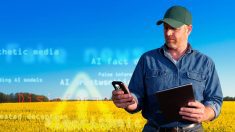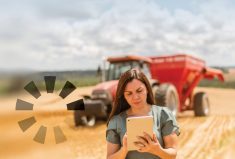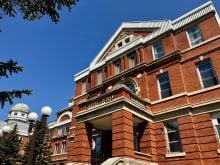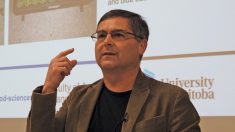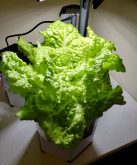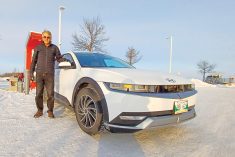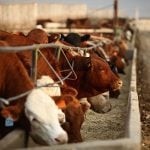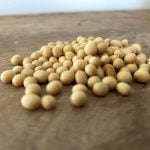R-Tech Industries of Homewood makes farm implements and, because its machines are often used by researchers, many of them come in strange shapes and sizes.
They’re small, narrow, miniature versions of the big iron you usually see working the fields in production season.
The smallest, strangest and narrowest of them all is the R-Tech Rover, a lightweight basic frame perched on four fat bike tires, designed for carrying instrumentation through soybean plots. It looks like a NASA tea trolley.
“The R-Tech Rover is a solar-powered, remote-operated, mobile platform purpose-built for TerraByte, the University of Winnipeg’s digital agriculture program,” Liam Riddell, general manager and mechanical engineer, said. “It’s a two-wheel chain drive with an electric motor driving each of the front wheels with a custom sprocket mounted to a fat bike tire.”
The lightweight frame is five feet square and has about four feet of clearance underneath so it can ride over a growing crop. The tracking width is variable so it can be adjusted to work in different plot sizes. The front wheels are the drive wheels and are manoeuvred by skid steering. The rear wheels are on casters allowing zero point turning. If needed, a flick of a switch will invert the controls so it can become rear-wheel drive. Currently it’s operated through remote control.
“In addition to the remote control, the control system includes the ability to interface with other systems allowing for a greater degree of autonomy that we can implement in the future,” Riddell said.

“The idea is to control it by scripts, say, ‘drive down this road, turn around and then come back.’ That would be step one and then develop more autonomy as testing proceeds.”
R-Tech developed the Rover when the TerraByte team from the University of Winnipeg came calling. TerraByte is a group of physics people, computer engineers and computer scientists and they wanted a small vehicle to navigate soybean plots to collect crop data. They planned to produce traditional photographs of the plants and use other sensors to produce hyperspectral images as well as 3D imaging.
They already had thousands of images taken in a lab setting but, to do it in the field, they needed a mobile wagon to carry the sensory equipment and cameras. With this kind of imagery and this much data the machine could ultimately help determine what types of plants are in the field and what condition the plants are in. On top of that it’s small enough to fit into the box of a short-bed pickup truck.
“So this will help advance their machine learning models and advance their artificial intelligence,” Riddell said. “The tasks they can do range from simple plant identification, classifying a plant as a crop or a weed and phenotyping as well as determining a plant or a crop’s health.”
“This technology was not on our radar until about a year ago when we were contacted by the University of Winnipeg to join their team,” added R-Tech owner Rob McClement.
“They explained what they needed, which was the semi-autonomous platform. Presently this will be guided by a person over the plots.”
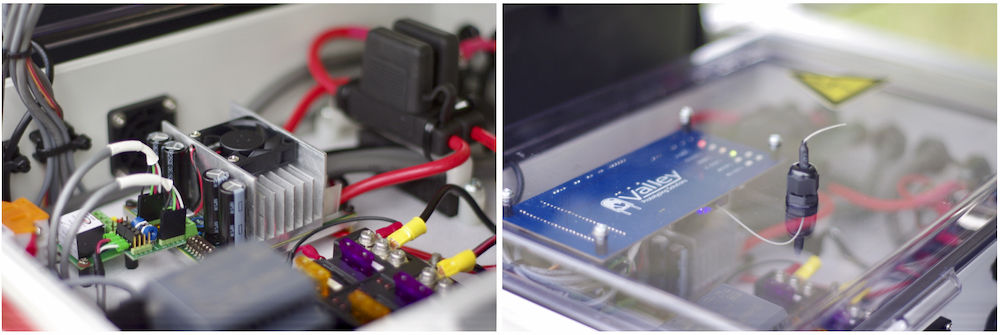
That’s what it does now but both note the potential of this little tea wagon is tremendous. McClement tells of bigger things with greater development. He sees it evolving into an even more useful tool with the addition of autonomous on-board georeferenced programming. Instead of a mere “down the road and back” it could use the same GPS information used by drones to move up and down fields on its own, collecting reams of data. It’s the next generation of crop scout.
“So that’s what a lot of its function might be,” he said. “Data is the new gold and it will allow producers to gather data to help optimize inputs, operation timing, nutrients, crop protection, insecticides, fungicides, you name it. If you have better data you can create meaningful and accurate prescription maps for people and they should get better economic output as well as a better environmental output.”
Read Also

VIDEO: Drone seeding aids cover crop planting
Manitoba cover crop trials test drone seeding against a traditional drill; the drone-seeded areas stood up on biomass production.
It doesn’t need to stop there either. If they can get the Rover to move on its own with a GPS sensor it could patrol the fields looking for problems before they erupt. With greater farm automation we could develop a variety of robots conducting the repetitive tasks that they’re good at.
McClement recounted his experience growing up on the farm, carrying a backpack sprayer for miles looking for milkweed or other nuisance plants. A companion to the Rover, carrying a small sprayer, could follow it or seek out weeds based on location data and do a quick spot spray while the weed population is still low. That could save a farmer the time and expense of blanket spraying a quarter section or more. It could lessen inputs, save money and, based on the data collected, help farmers make really smart, highly localized decisions that could keep small trouble small.
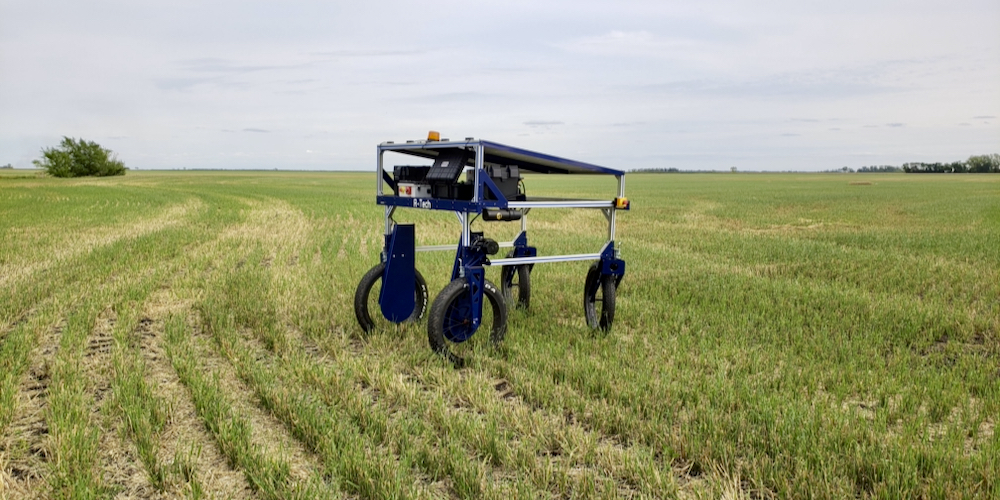
“We’re imagining the Rover or scout lite which wouldn’t have a lot of carrying capacity but would be able to carry the sensing equipment,” he said. “Then there might be a heavier version that would perhaps be able to have the spot sprayer, the soil sample device, that sort of thing.”
A top level robot scout could be the front line in plant identification, identifying weed populations and densities, vegetative mass, health, nutrient deficiencies, disease potential, even things like insect infestations. There’s still work to be done though.
“For this to evolve into a more useful tool where it can replace the simple repetitive tasks of collecting the data on field after field after field it will have to be self-guided and self-controlled,” McClement said. “If you’ve got a robot, a field machine that would do that, you don’t have to tie up human resources. Send it off and let it do its work.”



